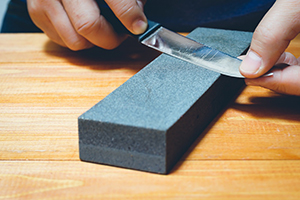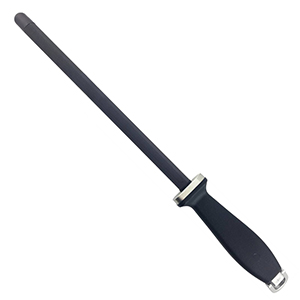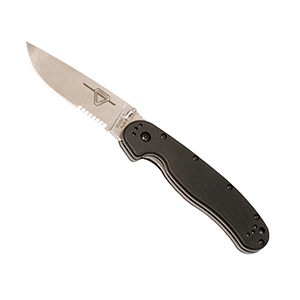10 Tips & Tricks for Sharpening Knives
Date Posted: 15 October 2019
 "A sharp knife is a safe knife," they say and nothing is truer than these words. When you compensate for a dull edge, you end up applying more force for cutting. It may be something people are used to doing but it can lead to serious injuries.
"A sharp knife is a safe knife," they say and nothing is truer than these words. When you compensate for a dull edge, you end up applying more force for cutting. It may be something people are used to doing but it can lead to serious injuries.
Because of the dullness, the knife may not completely bite into the object you are cutting. It will catch you by surprise when it frees itself from the object. Often, there is a continuing momentum that can unexpectedly slash you.
Sharpening knives is more of an experience than a solid set of rules. It is a lifelong journey that you cannot perfect overnight. However, it is essential to know how to sharpen a knife properly.
Even though you have one of the best knives in the world, such as Antonini, Cudeman, or Fallkniven, they will not function the way they should if they are dull.
Materials Used to Sharpen Knives
First, let us look at the different materials used to sharpen knives. The most common are:
1. Whetstones
The sharp result is one of the reasons why whetstones are popular. There are various types of stones used for every sharpening phase, such as ceramic. Using this method ensures a long lifespan for your knives. Whetstones are incredibly useful for regrinding dull knives, as well as maintaining sharp ones. If you need a thinner knife, whetstones can also be used.
The problem with whetstones is that they require skill. It may take some time to understand how it works.

2. Sharpening Steel
For quick maintenance, you can use a sharpening steel, such as the Fallkniven C10 Ceramic Sharpening Steel, which delivers quick results. It also helps in retaining the durability of the knife. If you have a blunt blade, however, a sharpening steel is not recommended (as well as for thinning knives).
3. Pull-through Sharpening Tools
These sharpeners are easy to use, but they can end up causing problems if you do not know how to use them. The fold of the edge can become jagged, which will only make your knife blunt. It offers sharpness but only for a limited time. It is also not used for thinning knives.
4. Electric Sharpeners
If you want fast results, an electric sharpener will help get rid of bluntness for you. It is easy to use but can be expensive. Also, you cannot use it for a knife with a full bolster.
The Knife Sharpening Process
How you sharpen your knife will mostly depend on the method you use. The following tips and tricks will lead you to a safe and successful knife sharpening process:
1. Know Your Stone
Before you start sharpening your stone, it is necessary that you know which tool you are using. It is why we have provided the methods above. Sharpening stones typically allow wet or dry usage. However, if you use oil, they can break down.
You should always take time to read the guidelines first. Oil may make the sharpening task easier for you. With the wrong type of stone though, the oil will slow down the process as it over-lubricates the surface. Plus, the cutting particles may clog the stone’s surface. You will end up with an undesirable result.

2. Make Sure the Stone is Stable
A slab-shaped whetstone can move and wiggle. You want it locked down in place, so it will not wobble. You may not be able to control the movement, which is dangerous and can result in an uneven pattern for the knife edge.
You may be used to holding the stone by hand, but now is the time to stop this practice. Use a log or any stationary object to secure the whetstone. This way, you can keep the knife at an angle that you can maintain throughout the sharpening process.
3. Know Your Strokes
You may not think it is important but you should count the number of strokes you do as you sharpen your knife. This way, you can use the same number on the other side of the edge. If you do not count, it can lead to over-sharpening one side. It is often noticeable when it is uneven, which can cause an odd bevelling on the blade’s edge.
4. Know Your Knife
Some knives may have different needs. For instance, you have a serrated knife, such as the Ontario Knife Company 8849 Rat Model 1 SS Serrated Folding Knife. A manual knife sharpener is often the best choice. There may be tools out there that are specific for serrated knives, but they usually do not do the job properly.
You may also use an electric sharpener but they may not be enough. They have spinning wheels that only sharpen the tips and edges, making them ineffective for knives with serrations. Therefore, the valleys between the tips remain dull.
Your next option may be to send the knives to a professional. However, there is an effective way that does not involve paying for a service. You can use a manual sharpener instead, which can take care of your knife regardless of its serrations. Manual sharpeners can be used on pointed, saw-toothed, and scalloped type of serration.
The good thing about serrated knives is that they do not require regular sharpening compared to those with smooth blades. They have pointed teeth that take care of the cutting work. The edges, on the other hand, do not receive as much friction as other types of knives.
5. Sharpen at a Constant Angle
When you sharpen a knife, you should stay at the same angle throughout the process. It is why you should carefully pick an angle first before you start.
6. Sharpen at the Right Angle
No matter what product you are working on, you should make sure that it is at the right angle. Typically, a 20-degree angle is recommended. Aim to maintain that angle as you sharpen the surface of the blade. Of course, keep it consistent as mentioned above.
7. Stay Easy
Easy does it, as they say, and it applies to the sharpening of knives as well. One mistake that beginners make when sharpening their knives is that they apply too much pressure on it. Think of it as throwing a bowling ball or swinging at a golf ball. You do not have to put in a lot of effort just so the ball goes straight or further.
When working on a sharpening tool and a knife, you should apply a very light grip. Then, keep it at a low pressure, this will give you optimal results. Let the tool or stone do the work. The only thing you need to do is to keep it at a constant angle with a steady pressure.
8. Do Not Wait for the Knife to Get Dull
People think sharpening knives is simple. It is why they delay the task until the blade becomes too blunt to use effectively. Unless you are prepared for a major sharpening job, it is much better to keep your knife sharp regularly. Frequent sharpening will keep your knives serviceable.
This common mistake should not be the way for you to learn how to sharpen knives. If it is your first time, start with an already sharp knife. You can even use a new knife for the sake of learning. New knives actually do not have a truly sharp edge, making them perfect for beginners. If you do not have one, go for a knife that you barely use. You can also watch someone else with experience in how to get things done.
9. Stay Consistent
Another mistake people make is that they change their technique when they do not see progress. It usually happens when you sharpen a knife that you have not touched in many years. If it does not look like the blades are getting sharper, it is not right to change your method – even if it already took 10 minutes of trying.
If you are getting tired, you can pause your work and get back to it. Make sure though that you use the same angle and technique – no changes whatsoever. Sometimes, it can take 30 minutes to sharpen a dull or worn edge. Patience is key.
10. Test the Blade
Once you are done sharpening your knife up, it is time to test it. The best way to check if it is sharp is to cut a sheet of paper using the knife. If the paper is cut cleanly without tearing, the blade is certainly sharp.
Of course, one obvious tip is to never test the sharpness on your arm hair, skin, or any part of your body. You can check using any inanimate object to ensure that you have done your job right.
Knives are useful tools, which is why you should always take care of them. Regularly sharpen them to experience their best performance. Whether you have a kitchen knife or one that you use for safety, you want something that you can rely on.
Keep in mind though that knives are dangerous. Make sure that you do everything that needs to be done for your safety. Avoid distractions while you sharpen them. Maintain your eyes, hands, and focus on the task at hand to prevent any accidents.
